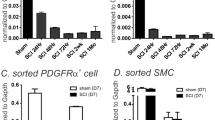Abstract
Objectives:
To determine the inhibitory effects of pudendal nerve stimulation (5 Hz) on bladder overactivity at the early stage of spinal cord injury (SCI) in dogs, and to explore the possible effects on delayed progression of bladder fibrosis after SCI.
Methods:
The study was performed using six dogs with spinal cord transection at the T9–T10 level. Group 1 (three dogs) underwent low-frequency electrical stimulation of the pudendal nerve 1 day after spinal cord transection. Group 2 (three dogs) underwent only spinal cord transection. All dogs underwent urodynamic examination at 1 and 3 months after SCI. The bladders were removed for histological examination of fibrosis at 3 months after SCI.
Results:
Bladder capacity and compliance were significantly increased (P<0.05) by pudendal nerve stimulation in group 1 when compared with group 2 at 1 and 3 months after SCI. Non-voiding contractions (NVCs) were inhibited in group 1 compared with group 2. Collagen fibers were significantly increased and elastic fibers were significantly decreased (P<0.05) in group 2 when compared with group 1.
Conclusion:
Early low-frequency pudendal nerve stimulation can inhibit detrusor overactivity (DO), increase bladder capacity and delay the progression of bladder fibrosis.
Similar content being viewed by others
Log in or create a free account to read this content
Gain free access to this article, as well as selected content from this journal and more on nature.com
or
References
Benevento BT, Sipski ML . Neurogenic bladder, neurogenic bowel, and sexual dysfunction in people with spinal cord injury. Phys Ther 2002; 82: 601–612.
Burns AS, Rivas DA, Ditunno JF . The management of neurogenic bladder and sexual dysfunction after spinal cord injury. Spine 2001; 26: 129–136.
Riccabona M, Koen M, Schindler M, Goedele B, Pycha A, Lusuardi L et al. Botulinum-A toxin injection into the detrusor: a safe alternative in the treatment of children with myelomeningocele with detrusor hyperreflexia. J Urol 2004; 171: 845–848.
Shingleton WB, Bodner DR . The development of urologic complications in relationship to bladder pressure in spinal cord injured patients. J Am Paraplegia Soc 1993; 16: 14–17.
Tai C, Wang J, Wang X, de Groat WC, Roppolo JR . Bladder inhibition or voiding induced by pudendal nerve stimulation in chronic spinal cord injured cats. Neurourol Urodyn 2007; 6: 570–577.
Lee YH, Kim JM, Im HT, Lee KW, Kim SH, Hur DM . Semiconditional electrical stimulation of pudendal nerve afferents stimulation to manage neurogenic detrusor overactivity in patients with spinal cord injury. Ann Rehabil Med 2011; 35: 605–612.
Opisso E, Borau A, Rodrigues A, Hansen J, Rijkhoff NJ . Patient controlled versus automatic stimulation of pudendal nerve affferents to treat neurogenic detrusor overactivity. J Urol 2008; 180: 1404–1408.
Chen G, Liao L, Dong Q, Ju Y . The Inhibitory effects of pudendal nerve stimulation on bladder overactivity of spinal cord injury in dogs: is early stimulation necessary? Neuromodulation 2012; 15: 232–237.
Abrams P, Cardozo L, Fall M, Griffiths D, Rosier P, Ulmsten U . The standardisation of terminology of lower urinary tract function: Report from the Standardisation Sub-committee of the International Continence Society. Neurourol Urodyn 2002; 21: 167–168.
Schäfer W, Abrams P, Liao L, Mattiasson A, Pesce F, Spangberg A . Good urodynamic practices: uroflowmetry, filling cystometry, and pressure-flow studies. Neurourol Urodyn 2002; 21: 261–274.
Perkash I . Long-term urologic management of the patient with spinal cord injury. Urol Clin North Am 1993; 20: 423–434.
Sahai A, Khan MS, Gregson N, Smith K, Dasgupta P, GKT Botulinum Study Group. Botulinum toxin for detrusor overactivity and symptoms of overactive bladder: where we are now and where we are going. Nat Clin Pract Urol 2007; 4: 379–386.
Changfeng T, Werner S, Warren MG, Karl-Dietrich S, Juan W, Yanhe J . Treatment of overactive bladder. ISS 2004; 7: 163–174.
Leng WW . Chancellor MB. How sacral nerve stimulation neuromodulation works. Urol Clin North Am 2005; 23: 11–18.
De Groat WC, Yoshimura N . Mechanisms underlying the recovery of lower urinary tract function following spinal cord injury. Prog Brain Res 2006; 152: 59–84.
Lindström S, Fall M, Carlsson CA, Erlandson BE . The neurophysiological basis of bladder inhibition in response to intravaginal electrical stimulation. J Urol 1983; 129: 405–410.
Deveaud CM, Macarak EJ, Kucich U, Ewalt DH, Abrams WR, Howard PS . Molecular analysis of collagens in bladder fibrosis. J Urol 1998; 160: 1518–1527.
German K, Bedwani J, Davies J, Brading AF, Stephenson TP . An assessment of the contribution of visco-elastic factors in the aetiology of poor compliance in the human neuropathic bladder. Br J Urol 1994; 74: 744–748.
McGuire EJ, Morrissey SG . The development of neurogenic vesical dysfunction after experimental spinal cord injury or sacral rhizotomy in non-human primates. J Urol 1982; 128: 1390–1393.
Ghoniem GM . Effect of bilateral sacral decentralization on detrusor contractility and passive properties in dogs. Neurourol Urodyn 1984; 3: 23–30.
Brading AF, Turner WH . The unstable bladder: towards a common mechanism. Br J Urol 1994; 73: 3–8.
Uvelius B, Mattiasson A . Detrusor collagen content in the denervated rat bladder. J Urol 1986; 136: 601–604.
Acknowledgements
The study was supported by the National Natural Science Foundation of China (Grant no. 81070607) and the China National Key Technology R&D Program (no. 2012BAI34B02).
Author information
Authors and Affiliations
Corresponding author
Ethics declarations
Competing interests
The authors declare no conflict of interest.
Rights and permissions
About this article
Cite this article
Li, P., Liao, L., Chen, G. et al. Early low-frequency stimulation of the pudendal nerve can inhibit detrusor overactivity and delay progress of bladder fibrosis in dogs with spinal cord injuries. Spinal Cord 51, 668–672 (2013). https://doi.org/10.1038/sc.2013.60
Received:
Revised:
Accepted:
Published:
Issue date:
DOI: https://doi.org/10.1038/sc.2013.60
Keywords
This article is cited by
-
Early interventions to prevent lower urinary tract dysfunction after spinal cord injury: a systematic review
Spinal Cord (2022)
-
Voiding Dysfunction and Upper Tract Deterioration after Spinal Cord Injury
Current Bladder Dysfunction Reports (2013)


